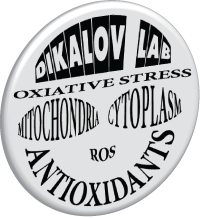
 |
|
||||
Research |
|||||
|
|
|||||
|
Despite the fact that the mitochondria are an important source of superoxide(O2·) in vascular cells, the role of mitochondrial O2· in endothelial dysfunction remains unclear. We have found that stimulation of endothelial cells with angiotensin II increases production of mitochondrial O2·. Overexpression of SOD2 or treatment with mitochondria-targeted SOD mimetic mitoTEMPO attenuates activation of vascular NADPH oxidases, inhibits production of cellular O2·, restores nitric oxide production, improves endothelium-dependent vasodilatation and reduces blood pressure in angiotensin II infused mice. Our work has demonstrated that angiotensin II-induced O2· production by NADPH oxidase stimulates mitochondrial O2· that in turn provides redox dependent feed forward stimulation of NADPH oxidase. This vicious cycle can be interrupted at the mitochondrial site by mitochondria targeted antioxidants. For the first time we have found that angiotensin II-induced hypertension was attenuated in SOD2 overexpressing transgenic mice. Furthermore, mitoTEMPO treatment after the onset of DOCA-salt or angiotensin II-induced hypertension significantly decreased blood pressure. These studies show that mitochondrial O2· is important for the development of hypertension and that antioxidant strategies specifically targeting this organelle could have therapeutic benefit in this and possibly other diseases.
Superoxide radical (O2·) plays an important role in the development of many pathological conditions. Nitroxides and their reduced hydroxylamine form are well known O2· scavengers. Development of cell permeable nitroxides and cyclic hydroxylamines can be beneficial both for site-specific detection of the O2· in biological systems and for pharmacological treatments of oxidative stress. In this work we discuss general principles for design of cationic, anionic and neutral nitroxides with various lipophilicity, cell permeability and site-specific subcellularaccumulation. We have synthesized a new set of nitroxides and their corresponding cyclic hydroxylamines for studies of extracellular, intracellular and mitochondrial O2· in intactcells and isolated mitochondriaand investigated pharmacological effect of mitochondria targeted nitroxides on oxidative stress in cells and in animal experiments. It was found that cyclic hydroxylamines rapidly react with O2· producing stable nitroxides which allowed site-specific O2· detection. Positively charged 1-hydroxy-2,2,6,6-tetramethylpiperidin-4-yl-trimethylammonium (CAT1H) allowed detection of extracellular O2· only. 1-Hydroxy-3-carboxy-2,2,5,5-tetramethylpyrrolidine (CPH) and 1-hydroxy-3-methoxycarbonyl-2,2,5,5-tetramethylpyrrolidine (CMH) detected increase in cytoplasm O2· production upon stimulation with PMA but only CMH and mitochondria-targeted 1-hydroxy-2,2,6,6-tetramethyl-4-(2-(triphenylphosphonio)acetamido)-piperidine (mitoTEMPOH) was suitable for detected of mitochondrial O2·. Treatment of hypertensive mice with mitoTEMPO reduced blood pressure, improved endothelial function, significantly improved animal survival in atherosclerosis. These studies show that pyrrolidine and piperidine-based nitroxides can be used for the development of site-specific antioxidants.
Mitochondrial and cellular reactive oxygen species (ROS) play important roles in both physiological and pathological processes. Different ROS, such as superoxide (O2·), hydrogen peroxide (H2O2), and peroxynitrite (ONOO─), stimulate distinct cell signaling pathways and lead to diverse outcomes depending on their amount and subcellular localization. A variety of methods have been developed for ROS detection; however, many of these methods are not specific, do not allow subcellular localization and can produce artifacts. We are critically analyzing ROS detection techniques in order to evaluate the advantages and the shortcomings of available methods. In the past decade a number of new fluorescent probes, electron spin resonance approaches and immunoassays have been developed. These new state-of-the-art methods provide improved selectivity and subcellular resolution for ROS detection. Although new methods for HPLC superoxide detection, application of fluorescent boronate-containing probes, use of cell-targeted hydroxylamine spin probes and immuno-spin trapping have been available for several years, there has been lack of translation of these into biomedical research, limiting their widespread use. Our lab is constantly working to improve ROS detection by developing new probes and translation of new technologies from the “test tube” to physiological applications in order to apply new methods in studies of mitochondrial and cellular ROS.
|
| ©2012 Dikalov Lab • Division of Clinical Pharmacology • Vanderbilt University | Home • Research • Collaboration • Publications • CV • Contacts |